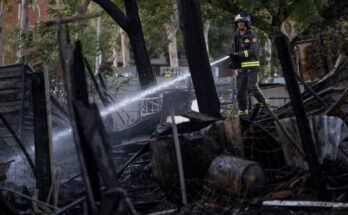Listen to José María Pérez, Peridiit’s as enjoyable as reading your daily strips. Perhaps reading is not the correct verb for that act of contemplation, nor does listening do justice to what happens to those who listen to the serene, orderly, wise and precise Spanish that comes out of his mouth. A language mixed from time to time with a leism that reveals (betrays it?) as originating from the mountains of Palencia, where it is a dialectal characteristic. They are nice pronouns, like the twists of a Romanesque bas-relief or the wavy lines of a cartoon.
From that wise bonhomie he sometimes places corrosive cruelties that his recipients forgive in advance. They say that Peridis is never aggressive or offensive, and it is true that he does not resort to insults or cheap or crude blows, but with his naive elegance he has signed some of the most penetrating caricatures in Spanish political history. He undressed all the powerful by resorting to symbolism and seemingly white, but ultimately devastating humor.
His victims love him. It would be monstrous to get angry in public over a caricature of him. This is why some have willingly witnessed the tribute offered by the program In the scoopthe series on the great Spanish journalists (produced by RTVE together with LACOproductora, the audiovisual production house of PRISA, publishing house of EL PAÍS), dedicates this week to him on La 2. Pablo Iglesias, Alfonso Guerra, Esperanza Aguirre and Alberto Ruiz-Gallardón recognize themselves in the mirror peridisiac and celebrate the privilege of having been portrayed by him. Gallardón even shares a table with him in a scene on the terrace of the Círculo de Bellas Artes, above the symbolic Madrid sky that he has filled with tunnels, and says he recognizes himself in the drawings (Peridis called him a pharaoh), even if he sees them as a little exaggerated. The latter can be a useless obviousness – caricature is hyperbole, there are no caricatures that don’t exaggerate – or a betrayal of the subconscious: the stinging residue of the wounds that those cartoons left in the ego.
They are politicians, of course, and their talent is to smile and dissemble, but they do not seem convincing in their praise. You sense in the flow of words, in the enunciation, in the twist of sentences and in the way of smiling, that Peridis reached to the bones, and nobody likes that feeling. The only one who allows himself some reproaches is Pablo Iglesias, who accuses him – sympathetically, but without ambiguity – of harboring a certain hatred for Podemos and of having been particularly cruel to his character.
It is natural that they listen and try to welcome him with sportsmanship, even celebrating him. Unintentionally, the documentary reminds us of something that current Spanish society easily forgets: we live in a democracy where the powerful have no choice but to smile at Peridis’ axe-wreck wrapped in kindness and naivety. All those called up for the program are retired politicians, but Peridis continues to publish his strips daily.
I’m convinced that the current protagonists are not so happy to see themselves in it.
Beyond these games of comparison and dissimulation, the portrait that Lara Siscar creates in Madrid and Aguilar de Campoo, Peridis’s two homes, is exciting and worthy of such a beloved and central figure of Spanish journalism. Peridis draws while Siscar asks him, and he explains how he came to characterize some characters, how he conceived that column, symbol of power, in which those who command the most sit (except Rajoy, who used an armchair). He calls himself a “puppeteer” because his designs are somewhat reminiscent of puppets, and he is generous in explaining his intentions and working processes.
“My intention is for the reader to move from the obvious to the symbolic,” he says, pointing to the key to his vault. Peridis, in fact, does not comment on current events, but rather transforms it into a symbol, stylizing it to achieve a meaning that it rarely has in news or columns made of words.
His role as a Roman activist is not overlooked, with a walk in the monastery of Santa María la Real, which he rebuilt from the ruins and which was the origin of the laboratory schools, of which he is very proud. Peridis shows Siscar some capitals with reliefs which, after analyzing their bands for a long time, are very reminiscent of his style as a designer. He confesses that Romanesque is his most important passion, and the spectator, perhaps inspired, wonders if there isn’t a lot of Romanesque also in the protagonist’s behavior, in his way of speaking Spanish, as if bouncing off a semicircular vault, and in the sarcastic and frank attitude with which he addresses all issues.
Rubén Amón appears in the program in the role of the son of Santiago, an art critic since the early years of this newspaper and a close accomplice of Peridis in his Romanesque crusade. Amón says that as a child he accompanied them in a French car on their travels through Spain, visiting ruined churches and monasteries, and spied on them from the back seat as they spoke passionately about medieval art. The voices of the friends resonate in the viewer’s imagination as if in the center of a cathedral, in a timeless place and in a space with pure and simple lines.
In the end Peridis reveals the meaning of life to Lara Siscar. Really, without subterfuge or irony. The program could not have ended in any other way, leaving the desire to continue enjoying for many years the genius, allergic to the solemn, of this passionate man from Palencia.



